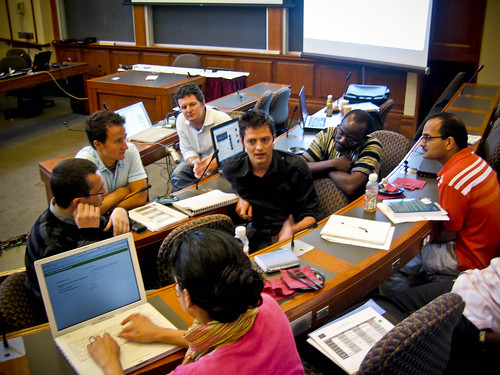I started with a discussion on what computer science actually is. After all, so many people have a misconception that it was likely these science and technology teachers did, too. It didn't take long to get down to the real answer with this group (great bunch!), but it still had to be done. After brainstorming, I started with my usual "big fancy definition" from Wikipedia:
Computer science (or computing science) is the study of the theoretical foundations of information and computation and their implementation and application in computer systems.("Bet that doesn't sound like something that would fit into your class!")
Then I gave my own take on what it was all about. This is the same list I show during outreach or even my Introduction to Computers for Arts and Social Sciences course.
Then I briefly showed them how computer science can connect to many different areas. In fact, I always say, give me anything you're interested in and I'll find a way to connect CS to it - after all, computers are everywhere! There's always a problem that can be solved with computing.
- It’s all about finding ways to figure stuff out.
- What can be computed automatically?
- How hard is it to compute?
- What cool applications are there? (Like video games, Facebook, and more)
- What’s the best way to set up a computer so it can do all this stuff fast?
So why should these teachers care about teaching CS to their students? As the stats show, computer science is suffering greatly from a lack of females (and from people in general - some stats say that we won't have enough talent to fill jobs in the near future!). One of the reasons seems to be that girls never find out what CS really is. (I always ask the girls I do outreach with to tell me why they think there aren't more women in CS, and this is a reason they consistently offer.)
If students make it to the computer labs, it's usually to learn how to type or write reports or do research online. Only about half the teachers present said their school even had computer science classes, and I'm willing to guess that among the courses that do exist, many of those teaching them don't have a CS background. So even if girls were to make it into a high school "computer science" course, what impression are they likely to leave with? There's a good chance they will think CS is all about programming boring example programs that aren't relevant to them.
But if we can show how computing connects to the courses they are taking (you know, the ones they are actually passionate about), we might get a few girls interested in considering at least a minor in CS, if nothing else.
So I told the teachers about CS Unplugged, and showed how the various activities could fit into other classes from art to history to biology or physics. In fact, I even have a document I made that suggests some of these connections (though I've thought of many more since writing it). I told them they could ask for my help if they wanted to be able to do some of the activities on their own, or said they could invite CU-WISE to come to their classes and do some activities for them.
I know at least a few in attendance were convinced of my position. Here's hoping that we can start infiltrating non-CS classes with some good old fashioned CS fun, and that some students will get hooked in the process.



















